Hey, welcome to Scrubday Sunday! Scrubday Sunday is a weekly feature where I explain the finer mechanics and strategies of a game for the benefit novices in the hope that it will alleviate the learning curve and hone your skills, or possibly entice you to try a game you might not have played yet. The first game I'm going to cover is the fantastic card game for iOS, Ascension: Chronicle of the Godslayer developed from it's original physical version for iOS by Incinerator Studios and Gary Games.
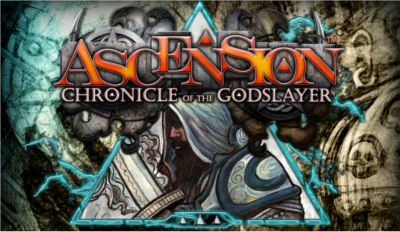
Ascension: Chronicle of the Godslayer is a dynamic deck building game, similar to a traditional card drafting tournament, except that competitors are too impatient to wait until the draft phase is finished to start playing. Each turn players play cards from their hand to buy cards from a common pool of six cards consisting of monsters, heroes, and constructs in the center of the table to build a better deck or to disrupt the strategy of the opponent. Every card has a has either a runic value points (how many points it adds to your ability to buy heroes and constructs), a power value (how much monster ass it kicks per turn), and a victory point value (how many points it adds at the end of the game to your final tally). The length of the game is limited by a pool of victory points that are diminished over time by the cards played from the player's hand or by defeating monster and cultist cards from the center set of six cards. When the victory point pool is reduced to zero, the game ends and the player with the most points from both the center pool and cumulative value of cards in their deck, wins. Typical games only last 30-40 turns, or about 30 minutes of play time. Since games are relatively short, a key part of the game is executing a game winning strategy in the fewest turns possible, while preventing your opponent from doing the same. With that in mind the first thing we're going to cover before we move on to game winning strategies is how to build the most efficient deck possible.
Deck Efficiency and You
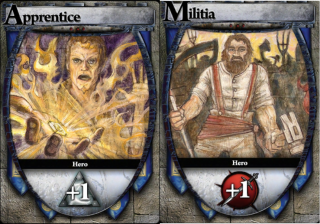
The first two things to consider are the ten cards that compose your deck at the beginning of the game and how those cards cripple your five card hand every turn. The ten cards you begin the game with consist of 8 apprentices and 2 militia, and to be blunt, they're terrible. These cards actively hate you and want you to fail, purely out of spite. They resent your attempts to acquire better cards and will muscle their way into your hand at every opportunity taking the place of more deserving, honest, hardworking cards. In mechanical terms, apprentices and militia hurt your deck efficiency by not being any other goddamn card in the game. They have the lowest possible runic or power value possible without being 0, they cause no special effects when played, and they contribute nothing to the final victory point total of your deck. Every other card in the game has them beat in at least two or more of these categories, and often by several magnitudes. Any time you draw either an apprentice or militia into your hand it takes the place of a more powerful card. Keeping in mind that our goal is to be playing quality cards more frequently and in greater quantities than our opponent, our first order of business is to remove all the apprentices and militia from our deck as expediently as possible. In essence there are three ways to reduce or eliminate the effect the starter cards have on deck efficiency: Banishing, card draw, and redundancy. Cleanliness is close to godliness, and since this is the Chronicles of the Godslayer, we want to get as close to ye gods as possible before we shank them.
Banishing: Strategically murdering cards as an example to the others.
The best way to go about eradicating your garbage cards is by banishing them to the void pile, permanently removing them from play. Banishing cards from your hand or discard pile is a property common to the Void set of cards (the purple cards). Banishing is a very powerful mechanic, it allows junk cards to be culled out of the deck so your good cards to float to the top of the deck more often. This lets you get more use out of fewer cards, and progressively reduces the chances of pulling an apprentice or militia into your hand on a turn where you would much rather have something more potent to play. However, it's important to note that you can accidentally hamstring your runic power generation by banishing all your apprentices before you have replaced them with more efficient cards. Remember to pace yourself when banishing your junk cards. A good rule of thumb is to at the very minimum replace the runic power lost by banishing at a one-to-one ratio. For every two apprentices banished, pick up a mystic if no equivalent or greater card is available in the center of the board. Ideally you want to have more than the eight runic power in your deck that this method prescribes, but at least this strategy will keep your head above water as the game progresses.
The Void Initiate and the Arbiter of the Precipice
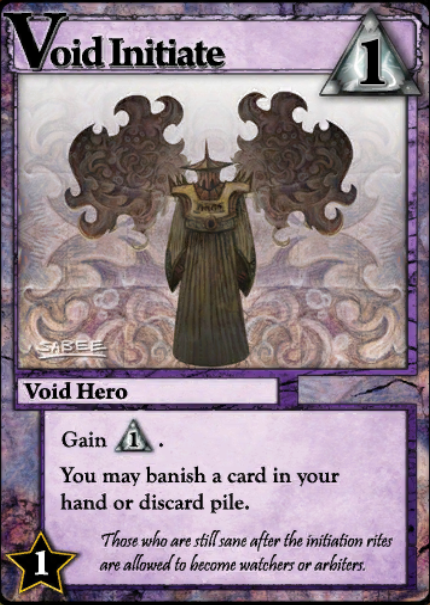
The prime example of the set is the Void Initiate. For the godslayer on a budget he's an great card to pick up costing just one rune and offering an equal return in victory cards. When played, he adds one rune to pool for the turn just like an apprentice, the real kicker though is that in addition to adding to your rune pool he banishes a card from either your hand or discard pile, essentially capping an apprentice in the back of the head and then taking his place. He also gives you the option of sparing the simpering whelp in the event that the single rune the apprentice provides is just enough to pick up a card from the draft pool that you want.
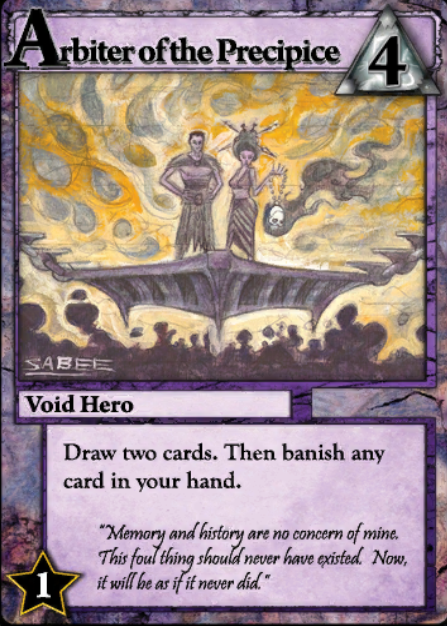
This gentlemen to the right however offers no quarter to cowards. The Arbiter of the Precipice combines the best aspects of the Void set's banishing properties and the Enlightened set's card drawing abilities. He's a bloodthirsty bastard though, requiring you to sacrifice a card from your hand to the void in return for the two cards he draws. Occasionally you'll manage to draw and hand with this fellow, and now apprentices or militia to feed him, leaving you with a Sophie's choice of which of your good cards you have to banish. There is a way around this potentially pain scenario, if you pay close attention to your hand and notice that you've drawn the Arbiter but no fodder to give him, you can just neglect to play him that turn, bypassing the need to banish a valuable card, but taking a pass on his card drawing ability.
Card Draw: Sweeping the garbage under the rug.
The Enlightened set of cards (the white cards) contain the bulk the of cards with properties that let you draw more cards into your hand in a single turn, giving you a way to subvert the junk in your deck is by simply drawing more cards per turn, brute forcing your way through the dead weight. By drawing more cards per turn you can diminish the damage done by drawing junk cards by having more cards to play. It's not exactly the elegant solution that the void set offers, as apprentices and militia still lurk in the bowels of your deck, potentially giving you a bum hand if you draw 3 or more of them in a single turn. It does have one powerful advantage over banishing however: the possibility of cascade turns.
A cascade turn as an event where the processes of drawing additional cards begets another card that repeats the effect. For example: you play a card that allows you to draw two more cards, bringing the total number of cards into your hand to six (5 cards in hand - 1 card played + 2 cards drawn = 6 cards). One of those two cards happens to be another card allowing you to draw and additional two cards, bringing the total to seven cards in hand and two in play. This processes can potentially continue until you've taken the equivalent of multiple turns.
The Ascetic, the Temple Librarian, and the All-Seeing Eye
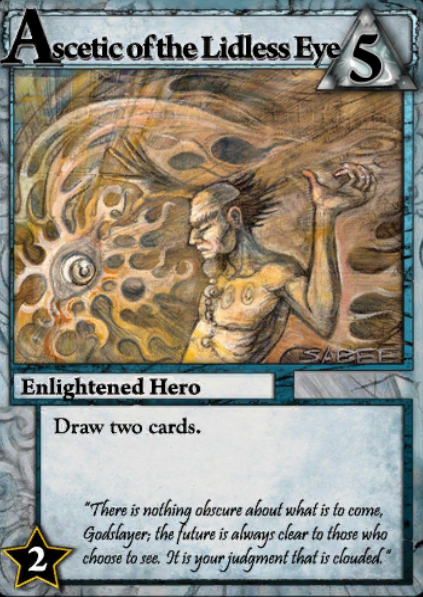
The Ascetic of the Lidless Eye, other then having a supremely badass name, is a refreshingly simple card mechanically. It does exactly what is says on the tin. Drop this fellow on the table, draw two more cards. Wash, rinse, repeat.
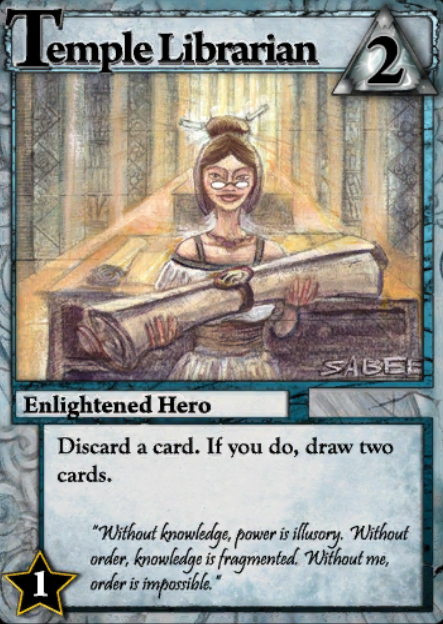
The Temple Librarian is similar to the Ascetic, but with the condition of discarding on card from hand to draw the additional two cards. This isn't necessarily a bad thing, because the discard pile is where we want our apprentices and militia to be anyway so that Void Initiates and analogous cards can banish them without them having to be in our hand. In addition, the Temple Librarian is kind enough to allow you to discard one of the two cards her effect lets you draw in the event that non of the cards in your hand suit the purpose. How considerate!
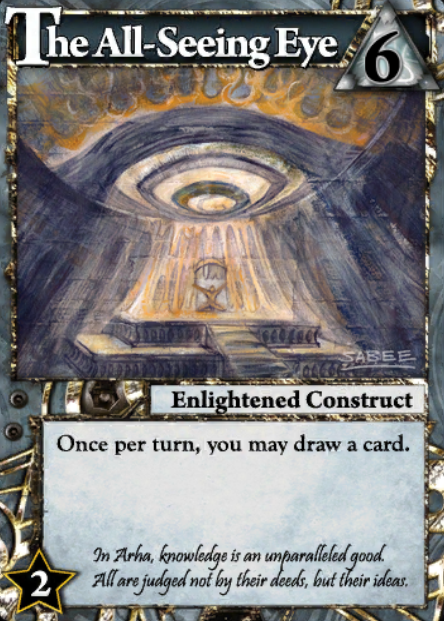
Last but not least we have The All-Seeing Eye. It's another Enlightened card with a simple mechanic. Think of it as an expansion pack to your hand, letting you play six cards rather then five ever turn. As an aside, it also combos well with a few of the Lifebound set of cards that allow you to pick up hero cards and place them on top of your draw deck. Just fire off the All-Seeing eye's effect and take the hero into hand so you can play it that turn. No muss, no fuss.
Redundancy: Because sometimes the cards screw you.
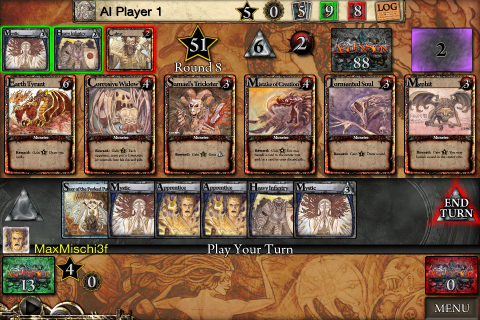
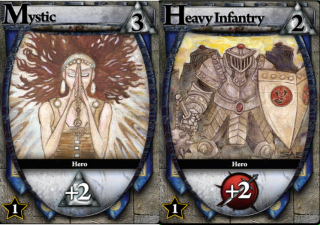
Occasionally, despite all your scheming and planning, the cards just take a dump on you. When that happens, you're left with least efficient option of just picking up as many mystics or heavy infantry as your runes will allow. This is really only stopgap measure because mystics and heavy infantry are only a hair above apprentices and militia in terms of usefulness. If there's absolutely nothing available to you in the center of the board, just buy up as many of these guys as you can to try and offset the starter deck and cross your fingers that better cards show up in the center as the game progresses.
A final note on the concept of "free" cards.
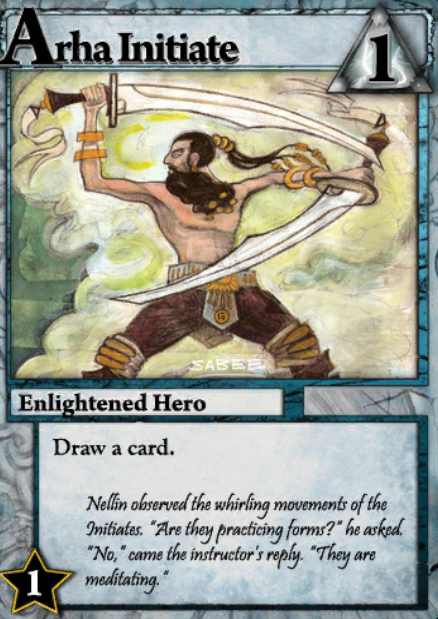
The last thing we're going to go over before moving on to the actual process of winning games is the concept of "free" cards. A free card is any card that replaces itself by allowing you to draw one additional card, or remains in play for the duration of the game. Cards like these essentially have no effect on the speed and efficiency because of the way they function, either replacing themselves when played, or by staying out of your hand while still providing their beneficial effects. Because of those two properties, you can pick up any cards that fit in those categories guilt-free of the weight they would otherwise add to your deck.
Arha Initiate
The quintessential example of the free card, it provides no additional benefit other then the victory point it adds to your deck, but adds no weight to your deck by replacing a card back into your hand when played.
Strategy, or the joys of watching the hope drain from your opponent's eyes
Now that your deck is humming along at a better clip it's time to strap some guns on this sucker and turn it into a well oiled nerd-crushing machine. There are only two ways to gain victory points in Ascension and they combine to form your final victory point total at the end of the game: draining the common pool of victory points, and the total victory point value of the cards in your deck. The goal of victory by point drain is to drain the common pool of points as quickly as possible, focusing on either cards with high combat power values or intrinsic point draining qualities, ending the game before your opponent can begin building a deck with a higher victory point value then yours. Conversely, victory by deck building is a purely economic venture. Focusing on cards that generate large quantities of runic power, the goal is to pick up as many cards with high victory point values as possible.
Victory by point drain
Killing monsters in the common pool of six cards is by far the most direct approach to draining the victory pool. Additionally, many of them have properties that allow you you screw with your opponent by banishing cards from the center pool, stealing a card form their hand, or forcing them to discard a number of their constructs. A deck built for victory point drain in this way is going to be built primarily around the Void, Enlightened, and Heavy Infantry cards.
The Shade of the Black Watch, the Demon Slayer, and Voidthirster
The Shade of the Black Watch combines to two best attributes of the Void set. He allows you both banish a card from your hand or discard pile increasing your deck efficiency, while also adding some combat value for your deck. A fantastic one-two punch of effects costing just three runes to pick up, he's pretty much a no-brainer if you're chasing monsters and cultists
The Demon Slayer is another one of those cards that does exactly what's printed on the tin. Pony up four runes and you get a guy who messes up monsters for a living. He's worth noting because he has a good cost to value ratio considering both his combat prowess, cheap cost, and victory point value.
Voidthirster is where things start to get more interesting. In Ascension, outside of the Mechana constructs, there aren't many cards with expressly synergistic qualities. Voidthirster is one of the exceptions, and if you're going monster hunting, you should make it a priority to pick this card up if it's available. Voidthirster's unique power is that in addition to adding to your combat value, it also gives you a additional victory point for the first monster you kill every turn. This includes Cultists, effectively doubling their victory point value for very little power. It's also worth noting that you can stack the effects of two identical constructs, so it's worth going after copies of this card if you can.
The Arha Templar and Oziah the Peerless
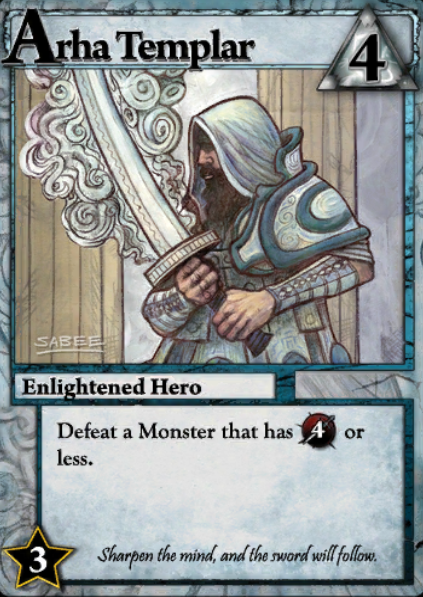
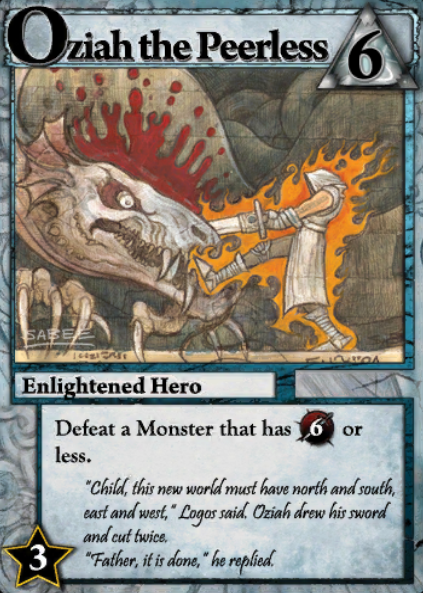
The Enlightened set also has some warriors mixed in with their card drawing powers. They differ in one very significant way from the Void fighters in that they operate as extremely powerful, single-target nukes. The advantage that the Enlightened monster hunters have over the Void fighters is that they're both more cost efficient, and worth more victory points then their Void counterparts. However, their combat ability is limited to effecting only a single card each, rather then being able to be divided between multiple cards. There are times when you may have to waste potential combat power on a lesser target like a Cultist just because nothing else is available at the time.
The Arha Templar and Oziah the Peerless give back single-target combat value equal to their runic power cost to require, four and six respectivly, they also have a great victory point to runic power cost ratio.
The Lifebound Initiate, Flytrap Witch, Snapdragon, and Yggdrasil Staff
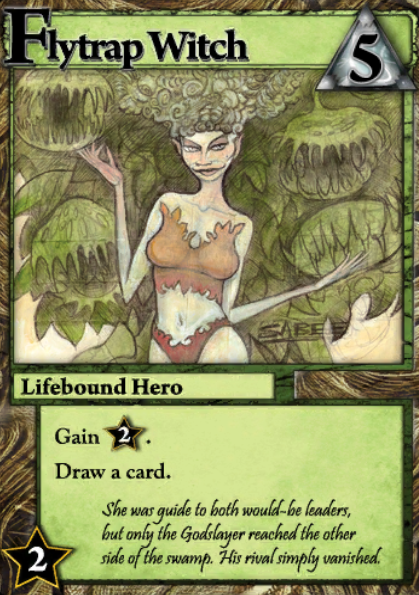
There is one more way to secure victory points from the common pool and that's through the Lifebound set's point bleeding effects. It's a slower burn then just straight monster hunting, but it adds up quickly putting the squeeze on your opponent.

The Lifebound Initiate and Flytrap Witch are the base of this strategy. The initiate gives you runes and reduces the victory point pool gradually while the flytrap Witch does the same minus the rune generation at a slightly faster rate. The real kickers are the Lifebound constructs. The Yggdrasil staff generates some additional combat power, but that's not the real draw of the card. It's unique mechanic is converting four spare runes into 3 victory points once per turn. If you've been building a rune heavy deck you can start draining the victory point pool rapidly without every having to go after any monsters. The Snapdragon is another little gem. Once per turn if you play a Lifebound hero, reduce the victory point pool by one. It also generates a rune for you once per turn every turn. This, like the Voidthirster, is capable of being stacked multiplying it's effects.
Victory by deck value
The other way to secure victory is through the cumulative value of the cards in your deck. The star players of this strategy are the Mechana constructs. Damn near every one of the cards is synergistic with the others making acquiring additional Mechana cost less, come directly into play when you purchase them, or draw additional cards for every Mechana construct you play. More importantly they also contribute victory points to your deck equal to their cost in runes to pick up! Other then that, the only real strategy involved is just playing your deck with an eye towards the value of the cards you pick up over the course of the game.
The Reactor Monk, the Hedron Link Device, and the Hedron Cannon
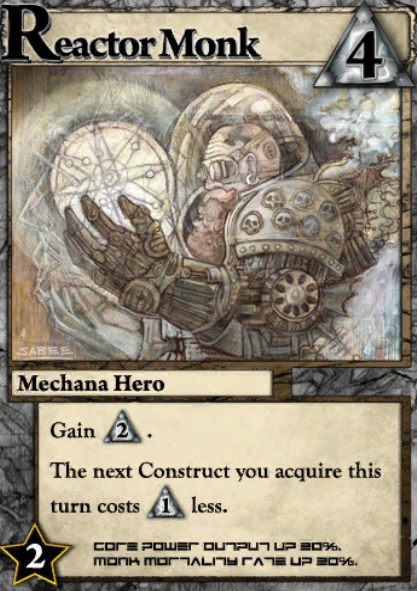
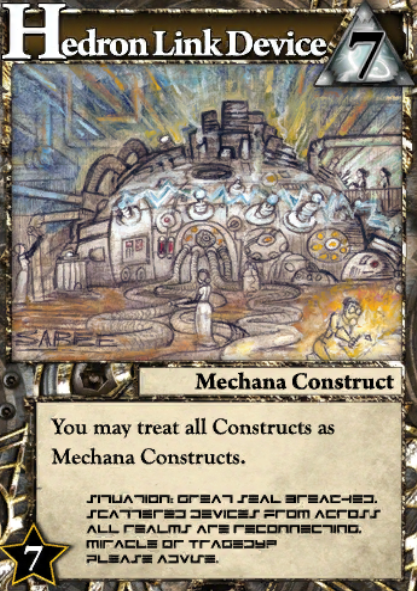
If you're going to shoot whole hog for picking up Mechana constructs and going for a deck points victory, the Reactor Monk is the way to go. He's relatively cheap at four runes. When you play him he gives you two additional runes for the turn and reduces the cost of all constructs by one rune. This card can feed constructs into the Hedron Link Device, which then turns them all into Mechana constructs that power the Hedron Cannon. See what I'm getting at here? Once this strategy gains momentum it just takes off.
Do onto others before they do onto you.
The final, most vital bit of knowledge I would like to impart is that in this game, is once someone has gained victory points either from the central pool, or through adding cards to their deck it's basically impossible to take those points away from them. There is a single, difficult to kill, rare monster card that allows you to steal a single card from the opponents hand, but more often then not if you use this card you're not going to come away with a Hedron Cannon, you're going to pull an Apprentice or Militia and look like an ass.
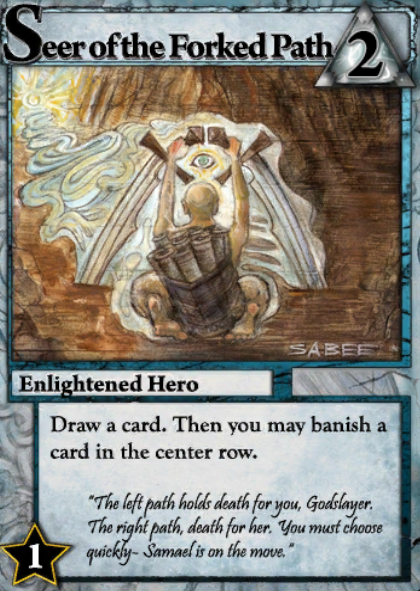
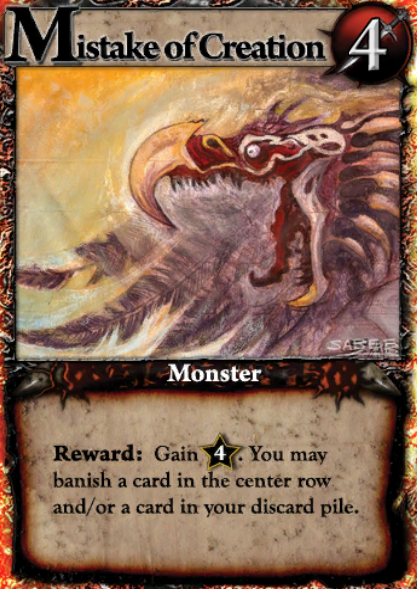
Your only active defense is to make sure anything your opponent could possibly use isn't there anymore when his turn comes around. The best way is by using Seers of the Forked path or Mistakes of Creation and some guesswork to figure out what your opponent is going to buy on his turn based on how he's been playing so far and his previous purchases. Make those cards go poof by banishing the buggers before he gets to pick up the card, pop the monster, or do whatever other devious, dastardly thing he has in mind before he does it to you. If you don't have any way to banish the card he wants, consider spite buying it. It's not the best way to go about it, but it's better that you have the card he wants then let him get it and use it against you.
That's it. I'm tapped the fuck out and you now know damn near everything I do about this card game. Go forth and kick some ass young gun.

Log in to comment